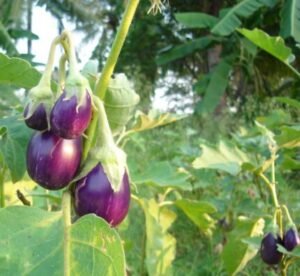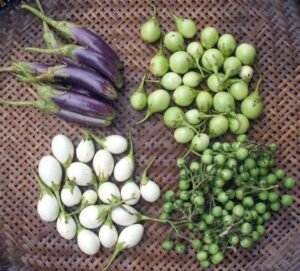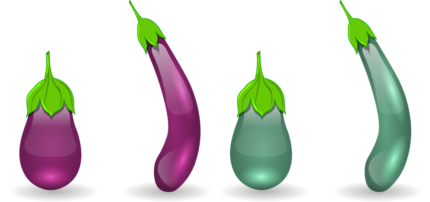Medically reviewed by Dr. Ramesh Gaddam, M.D. — Written by Sumalatha, D.N.H.E
Brinjal (Egg Plant)
Brinjal is a term commonly used in some parts of the world, including India and the United Kingdom, to refer to what is known as “eggplant” in the United States and Canada.
Eggplant (Solanum melongena) is a vegetable that belongs to the nightshade family (Solanaceae) and is known for its dark purple or blackish-purple skin.
However, there are also other varieties of eggplants that come in different colors, such as white, green, or even striped.
purple and green EggplantEggplants are versatile vegetables used in various cuisines around the world.
They have a mild, slightly bitter flavor and a spongy texture.
Common dishes that feature eggplant include baba ghanoush, moussaka, ratatouille, and eggplant parmesan.
They can be grilled, roasted, sautéed, or used in stews and curries. Eggplants are a good source of dietary fiber and contain vitamins and minerals like vitamin K, vitamin C, vitamin B6, and potassium.
The term “brinjal” is derived from the Portuguese word “beringela” and is commonly used in countries influenced by British English, while “eggplant” is the more common term in North America.
Regardless of the name, eggplants are a delicious and nutritious addition to many dishes.

Brinjal Nutrition
Nutritional information for 100 grams of raw eggplant (brinjal):
| Nutrient | Amount per 100g |
|---|---|
| Calories | 25 calories |
| Protein | 0.98 grams |
| Carbohydrates | 5.88 grams |
| Dietary Fiber | 3 grams |
| Sugars | 3.53 grams |
| Fat | 0.18 grams |
| Vitamin C | 2.2 milligrams |
| Vitamin K | 3.5 micrograms |
| Vitamin B6 | 0.084 milligrams |
| Folate | 22 micrograms |
| Potassium | 230 milligrams |
| Magnesium | 14 milligrams |
| Phosphorus | 24 milligrams |
| Iron | 0.23 milligrams |
| Calcium | 9 milligrams |

Brinjal Benefits
1. Low in Calories
Eggplant is a low-calorie vegetable, making it a suitable choice for weight management and calorie-conscious diets.
2. Rich in Dietary Fiber
Eggplant is a good source of dietary fiber, which can help promote digestive health, prevent constipation, and support a feeling of fullness, aiding in weight control.
3. Antioxidant Properties
Eggplants contain antioxidants like nasunin, which may help protect cells from oxidative damage and reduce the risk of chronic diseases.
4. Heart Health
The fiber, potassium, and antioxidants in eggplants can contribute to heart health by helping to lower blood pressure and reduce the risk of cardiovascular issues.
5. Blood Sugar Management
Some studies suggest that certain compounds in eggplants may help regulate blood sugar levels, making it potentially beneficial for individuals with diabetes.
6. Weight Management
The high fiber content in eggplants can help with weight management by promoting a feeling of fullness and reducing overall calorie intake.
7. Nutrient Content
Eggplants contain various vitamins and minerals, including vitamin K, vitamin C, vitamin B6, folate, and potassium, contributing to overall health and well-being.
8. Bone Health
Eggplants are a source of vitamin K and calcium, which are important for bone health and can help maintain strong bones.
9. Skin Health
Some components of eggplants, like nasunin and anthocyanins, have antioxidant properties that may help protect the skin from damage caused by UV rays and other environmental factors.
10. Cancer Prevention
While more research is needed, some studies have suggested that the antioxidants and phytonutrients in eggplants may have a role in cancer prevention.

Brinjal benefits for skin
1. Antioxidant Properties
- Skin Protection:
- Brinjal contains antioxidants like vitamin C and phenolic compounds that help protect the skin from oxidative stress caused by free radicals.
- This can contribute to healthier and more youthful-looking skin.
2. Skin Hydration
- Moisturization:
- Brinjal has a high water content, which can help keep the skin hydrated and prevent dryness.
- Well-hydrated skin is less prone to issues like flakiness and irritation.
3. Anti-Inflammatory Effects
- Reducing Inflammation:
- Compounds in brinjal may have anti-inflammatory properties.
- Consuming or topically applying brinjal extracts can help reduce skin inflammation, redness, and irritation.
4. Skin Brightening
- Reducing Skin Darkening:
- The antioxidants in brinjal can contribute to skin brightening by reducing the appearance of dark spots and blemishes.
- This can result in a more even skin tone.
5. Promoting Skin Health
- Nutrient Support:
- Brinjal provides vitamins and minerals like vitamin C, which are essential for maintaining healthy skin.
- These nutrients can support collagen production and skin repair.
6. Managing Skin Conditions
- Eczema and Acne:
- Some individuals find relief from skin conditions like eczema and acne by incorporating brinjal into their diet.
- Its anti-inflammatory and antioxidant properties may help soothe these conditions.
Brinjal benefits for male
1. Heart Health
- Cardiovascular Support:
- Brinjal’s high fiber content and antioxidants can contribute to heart health by helping to manage cholesterol levels and reduce the risk of heart disease.
2. Blood Sugar Management
- Regulating Blood Sugar:
- The dietary fiber in brinjal can assist in stabilizing blood sugar levels, which is important for overall health, including men’s health.
3. Weight Management
- Weight Control:
- Brinjal is low in calories and high in fiber, making it a valuable addition to a weight management or weight loss plan, which can benefit men’s overall health.
4. Antioxidant Protection
- Oxidative Stress Reduction:
- The antioxidants in brinjal can help protect cells from oxidative damage, potentially reducing the risk of chronic diseases, including those affecting men’s health.
5. Prostate Health
- Lycopene Content:
- Some varieties of brinjal contain lycopene, an antioxidant that has been linked to potential benefits for prostate health.
6. Digestive Health
- Gut Health:
- The fiber in brinjal supports healthy digestion and regular bowel movements, which is essential for men’s overall well-being.
7. Nutrient Density
- Essential Nutrients:
- Brinjal provides vitamins and minerals, including vitamin C, vitamin K, potassium, and others, which are important for men’s health and overall vitality.
While brinjal can be part of a balanced diet that contributes to men’s health, it’s important to maintain a varied and nutritious diet, engage in regular physical activity, and
consult with a healthcare provider for personalized health advice and recommendations.
Brinjal benefits for hair
1. Hair Growth
- Rich in Nutrients:
- Brinjal is a source of vitamins and minerals that are beneficial for hair health, such as vitamin C and B-vitamins.
- These nutrients can support hair growth and strengthen hair follicles.
2. Improved Scalp Health
- Scalp Nourishment:
- The vitamins and antioxidants in brinjal can help nourish the scalp and reduce scalp dryness or flakiness
- . A healthy scalp is essential for promoting strong and vibrant hair.
3. Reduced Hair Fall
- Strengthening Hair:
- Brinjal’s vitamin and mineral content can contribute to hair strength, reducing hair fall and breakage.
- It may help in maintaining a fuller and thicker head of hair.
4. Preventing Premature Graying
- Antioxidant Protection:
- The antioxidants in brinjal can help protect hair follicles from premature aging.
- This may delay the onset of gray hair and maintain natural hair color for longer.
5. Natural Shine
- Enhanced Luster:
- The vitamins and nutrients in brinjal can add shine and luster to your hair, making it look healthier and more attractive.
6. Managing Dandruff
- Anti-Inflammatory Effects:
- Brinjal’s anti-inflammatory properties may help reduce scalp inflammation and soothe conditions like dandruff, providing relief and promoting overall scalp health.
Brinjal benefits for skin whitening
1. Skin Brightening
- Reducing Dark Spots:
- Brinjal contains antioxidants like vitamin C and phenolic compounds that can help reduce the appearance of dark spots and blemishes, resulting in a more even skin tone.
2. Protection from UV Damage
- UV Radiation Defense:
- The antioxidants in brinjal can provide some level of protection against the harmful effects of UV radiation, which can lead to skin darkening and premature aging.
3. Hydration
- Moisturization:
- Brinjal has a high water content, which can help keep the skin hydrated.
- Well-hydrated skin often appears brighter and healthier.
4. Antioxidant Properties
- Fighting Free Radicals:
- Antioxidants in brinjal can neutralize free radicals that cause oxidative stress and skin damage.
- This can contribute to a healthier complexion.
5. Skin Lightening Masks
- DIY Face Masks:
- Some people use brinjal in homemade face masks to potentially improve skin texture and promote a brighter appearance.
- These masks often combine brinjal with other natural ingredients like honey or yogurt.
6. Skin Health Support
- Overall Skin Health:
- Brinjal provides vitamins and minerals like vitamin C and B-vitamins, which are essential for maintaining healthy skin.
- These nutrients support collagen production and skin repair.
Brinjal benefits for babies
1. Nutrient-Rich
- Nutrient Content:
- Brinjal is a source of essential nutrients such as dietary fiber, vitamins (including vitamin C and vitamin K), and minerals (like potassium and magnesium), which can contribute to a baby’s overall nutrition.
2. Introduction to Variety
- Dietary Diversity:
- Introducing brinjal as part of a baby’s diet can help diversify their food choices and expose them to different tastes and textures, promoting a well-rounded palate.
3. Dietary Fiber
- Digestive Health:
- The dietary fiber in brinjal can support a baby’s digestive system by aiding regular bowel movements and preventing constipation.
4. Antioxidants
- Antioxidant Protection:
- The antioxidants in brinjal, such as vitamin C, help protect a baby’s body from oxidative stress and boost their immune system.
5. Versatile Ingredient
- Culinary Variety:
- Brinjal can be incorporated into baby food recipes, such as purees, mashes, or mixed with other vegetables, adding variety to their meals.
6. Iron Absorption
- Iron-Rich Combinations:
- Pairing brinjal with iron-rich foods can enhance iron absorption, which is essential for a baby’s growth and development.
7. Development Support
- Vitamin K:
- Brinjal contains vitamin K, which plays a role in blood clotting and bone health, supporting a baby’s growth and development.
When introducing brinjal to a baby’s diet, it’s important to do so in a way that aligns with their age and stage of development.
Start with small portions, monitor for any adverse reactions, and consult with a pediatrician or a healthcare provider for guidance on introducing new foods to your baby’s diet
Brinjal benefits for weight loss
1. Low in Calories
- Caloric Value:
- Brinjal is a low-calorie vegetable, making it a suitable choice for those looking to manage their weight.
- Consuming fewer calories than you expend is crucial for weight loss.
2. Dietary Fiber
- Appetite Control:
- Brinjal is a good source of dietary fiber, which can help promote a feeling of fullness and reduce overeating, aiding in weight management.
3. Low in Fat
- Reduced Fat Intake: Brinjal is naturally low in fat, making it a healthy choice for individuals looking to reduce their fat intake as part of a weight loss plan.
4. Nutrient Density
- Nutrient-Rich:
- Brinjal provides essential nutrients like vitamins, minerals, and antioxidants, ensuring you receive necessary nutrition while managing your calorie intake.
5. Blood Sugar Management
- Stabilizing Blood Sugar:
- The fiber in brinjal can help regulate blood sugar levels, reducing spikes and crashes that may lead to overeating.
6. Versatile and Low-Fat Cooking
- Healthy Cooking Options:
- Brinjal can be prepared in various low-fat cooking methods, such as roasting, grilling, or sautéing, to minimize added calories from cooking oils.
7. Satiety
- Feeling Full:
- The combination of dietary fiber and low calorie content can contribute to a sense of satiety, preventing excessive snacking or overconsumption of high-calorie foods.
It’s important to remember that while brinjal can be a part of a weight loss-friendly diet, overall dietary choices and physical activity are also crucial factors in achieving and maintaining a healthy weight.
Consult with a healthcare provider or nutritionist for personalized advice and strategies tailored to your weight loss goals.

Brinjal Uses
Culinary Uses
Brinjal is a versatile vegetable used in a wide range of culinary dishes around the world.
It can be prepared in various ways, including grilling, roasting, sautéing, and frying. Some popular culinary uses include:
Baingan Bharta: A popular Indian dish made by roasting eggplant and mixing it with spices and herbs.
Moussaka: A Greek casserole dish that features layers of eggplant, meat, and bechamel sauce.
Eggplant Parmesan: An Italian favorite where eggplant slices are breaded, fried, and layered with tomato sauce and cheese.
Ratatouille: A classic French dish made with eggplant, zucchini, peppers, and tomatoes.
2. Vegetarian and Vegan Alternatives
Brinjal is often used as a meat substitute in vegetarian and vegan diets due to its hearty texture. It can be used in place of meat in dishes like:
Eggplant “Steaks”: Thick eggplant slices grilled or roasted with seasonings can mimic the texture of meat.
Eggplant Burgers: Ground eggplant mixed with other ingredients can be shaped into burger patties.
3. Condiments and Dips
Eggplant can be used to make condiments and dips that add flavor to a variety of dishes:
Baba Ghanoush: A popular Middle Eastern dip made from roasted eggplant, tahini, garlic, lemon juice, and olive oil.
Eggplant Chutney: A flavorful South Asian condiment made with eggplant, spices, and sometimes tamarind.
4. Pickling
Eggplant can be pickled and used as a condiment in some cuisines.
Pickled eggplant is often seasoned with herbs and spices and adds a tangy flavor to dishes.
5. Soups and Stews
Eggplant can be added to soups and stews to enhance their texture and flavor.
It’s commonly used in Mediterranean and Middle Eastern dishes like vegetable stews and tagines.
6. Asian and Southeast Asian Cuisine
In Asian and Southeast Asian cuisines, brinjal is used in various curries, stir-fries, and spicy dishes.
It’s a key ingredient in dishes like Thai green curry and Szechuan eggplant.
7. Appetizers and Snacks
Eggplant can be used to make delicious appetizers and snacks, such as eggplant fries or eggplant chips.
These can be served with dipping sauces.
8. Stuffed Eggplant
Eggplant can be hollowed out and stuffed with a variety of fillings, such as rice, vegetables, and spices, then baked until tender.
9. Eggplant in Pasta Dishes
Sliced or cubed eggplant can be added to pasta dishes, providing a unique texture and flavor.
It’s commonly used in dishes like eggplant pasta and eggplant lasagna.

Brinjal Side Effects
1. Allergic Reactions
Some individuals may experience allergic reactions to eggplants, leading to symptoms like itching, hives, swelling, and difficulty breathing.
If you suspect an eggplant allergy, seek immediate medical attention.
2. Digestive Issues
The high fiber content in eggplants can sometimes cause digestive discomfort, including gas, bloating, or diarrhea, especially in people not accustomed to a high-fiber diet.
3. Solanine Content
Eggplants contain solanine, a natural chemical found in nightshade vegetables.
While eggplants typically have low solanine levels, green and unripe eggplants may have higher concentrations. It’s advisable to avoid consuming green or unripe eggplants.
4. Kidney Stones
Eggplants are rich in oxalates, which can contribute to the formation of kidney stones in susceptible individuals.
People prone to kidney stones should moderate their intake of oxalate-rich foods, including eggplant.
5. Interference with Iron Absorption
Some studies suggest that eggplants may contain compounds that can interfere with the absorption of non-heme iron (found in plant-based foods).
This can be a concern for individuals with iron-deficiency anemia.
6. Medication Interactions
Eggplants may interact with certain medications, particularly those that affect blood clotting.
If you are taking blood-thinning medication, consult your healthcare provider to determine if there are potential interactions.
Brinjal in Pregnancy
1. Nutritional Benefits
Eggplants can be a nutritious addition to a pregnant woman’s diet.
They provide essential vitamins, minerals, and dietary fiber, which can contribute to overall health during pregnancy.
2. Folate Content
Eggplants contain folate, an important B-vitamin that is crucial for the development of the fetal neural tube.
Adequate folate intake can help reduce the risk of certain birth defects.
3. Moderation Is Key
While eggplants can offer nutritional benefits, it’s important to consume them in moderation during pregnancy.
Excessive consumption may not be advisable due to certain potential side effects and considerations.
4. Solanine and Unripe Eggplants
Pregnant women should be cautious about consuming green or unripe eggplants, as they may contain higher levels of solanine, a natural chemical that could be harmful in excess.
It’s best to opt for fully ripe eggplants.
5. Fiber and Digestive Comfort
The high fiber content in eggplants may contribute to digestive discomfort such as gas or bloating.
Pregnant women, who may already experience digestive changes, should be mindful of their fiber intake and cook eggplants thoroughly to reduce these effects.
6. Consult with Healthcare Provider
Pregnant women should consult with their healthcare provider or a registered dietitian to ensure that eggplants and other dietary choices align with their specific nutritional needs and health status during pregnancy.
7. Varied Diet
It’s advisable to maintain a balanced and varied diet during pregnancy.
Incorporating a wide range of fruits and vegetables, including eggplants, can help ensure that you receive a diverse array of nutrients to support both your health and your baby’s development.

Types of Brinjal
1. Purple Eggplant
Description: This is the most common type of eggplant, known for its glossy, deep purple skin and creamy white flesh.
Usage: Purple eggplants are versatile and can be used in a wide range of dishes, from grilling to roasting and stir-frying.
2. Japanese Eggplant
Description: Japanese eggplants are elongated with thin, tender skin. They typically come in shades of dark purple or lavender.
Usage: They are popular in Asian cuisine and are often used in stir-fries, tempura, or grilled dishes.
3. White Eggplant
Description: White eggplants are smaller than the common purple varieties and have pale white or cream-colored skin.
Usage: They have a delicate flavor and are often used in Mediterranean and Italian dishes, such as eggplant parmesan.
4. Green Eggplant (Thai or Indian)
Description: Green eggplants, also known as Thai or Indian eggplants, are small, round, and green in color.
Usage: They are common in Southeast Asian and Indian cuisines, used in curries, stir-fries, and pickles.
5. Rosa Bianca Eggplant
Description: Rosa Bianca eggplants are round to oval-shaped with stunning lavender and white striped skin.
Usage: They have a sweet and mild flavor, making them a favorite for grilling or roasting.
6. Italian Eggplant
Description: Italian eggplants are similar to the classic purple variety but are smaller in size and have a more oval shape.
Usage: They are often used in Italian recipes like caponata and ratatouille.
7. Indian Round Eggplant
Description: These are small, round eggplants with a deep purple skin and a slightly bitter flavor.
Usage: They are commonly used in Indian dishes, including bhartas and curries.
8. Black Beauty Eggplant
Description: Black Beauty eggplants are large, dark purple, and oval-shaped.
Usage: They are often used for making eggplant parmesan due to their size and meaty texture.
Brinjal Vitamins
1. Vitamin C
Description: Vitamin C is an antioxidant that plays a crucial role in immune function and the growth and repair of body tissues.
In Brinjal: Brinjal contains a moderate amount of vitamin C, contributing to overall health and its antioxidant properties.
2. Vitamin K
Description: Vitamin K is essential for blood clotting, bone health, and wound healing.
In Brinjal: Brinjal provides vitamin K, which is important for bone health and other bodily functions.
3. Vitamin B6
Description: Vitamin B6, also known as pyridoxine, is important for brain development and function, as well as the production of hormones and neurotransmitters.
In Brinjal: Brinjal contains vitamin B6, contributing to various metabolic processes in the body.
4. Folate (Vitamin B9)
Description: Folate, or vitamin B9, is crucial for cell division and the formation of DNA. It is particularly important during pregnancy for the development of the baby’s neural tube.
In Brinjal: Brinjal contains folate, which can support overall health and may be beneficial during pregnancy.
While brinjal is not exceptionally high in these vitamins, it still contributes to your overall nutrient intake when included as part of a balanced diet. These vitamins are important for various bodily functions and should be obtained from a variety of food sources for optimal health.
Calories in Brinjal (Eggplant)
Description: Brinjal, or eggplant, is a low-calorie vegetable.
Caloric Value: On average, 100 grams of raw eggplant contains approximately 25 calories. The calorie content may vary slightly based on the size and variety of the eggplant.
Brinjal is a great choice for those looking to maintain a low-calorie diet or manage their caloric intake, as it can be included in various recipes without significantly increasing the overall calorie count of a meal.
Frequently Asked Questions
What Happens if We Eat Brinjal During Pregnancy?
Effects: Eating brinjal during pregnancy is generally safe in moderation.
It provides essential nutrients like folate, but excessive consumption should be avoided due to potential digestive discomfort.
Ensure that it’s cooked properly to minimize any potential side effects.
Scientific Name of Brinjal
- Scientific Name: The scientific name of brinjal is “Solanum melongena.”
How to Make Brinjal Fry
To make brinjal fry, start by slicing brinjal into thin rounds, marinate with spices and seasonings, and then deep-fry or shallow-fry until they are crispy and golden brown.
How to Make Brinjal Curry
Brinjal Curry Recipe: Brinjal curry can be prepared in various ways, depending on the cuisine.
In general, you can cook brinjal with a mix of spices, tomatoes, and other vegetables or proteins, simmering until it’s tender and flavorful.
Different regions have their own variations of brinjal curry.
Why Brinjal Is Called Eggplant
Name Origin:
The term “eggplant” is derived from the shape and size of certain varieties of brinjal that resemble the shape and color of chicken eggs.
In contrast, “brinjal” is a term commonly used in some parts of the world.
Brinjal Is Which Part of Plant
Botanical Classification:
Brinjal, or eggplant, is the fruit of the Solanum melongena plant, which belongs to the nightshade family (Solanaceae).
Why BT Brinjal Banned in India
Ban Reasons:
Bt brinjal, a genetically modified (GM) crop, faced controversy and concerns regarding its safety and potential environmental impact.
India’s government imposed a moratorium on its commercial cultivation to assess the potential risks and benefits further.
What Is BT Brinjal
BT Brinjal Description:
Bt brinjal is a genetically modified variety of eggplant.
It contains a gene from the bacterium Bacillus thuringiensis (Bt) that produces a protein toxic to certain insect pests, reducing the need for chemical pesticides.
Brinjal Contains Which Vitamin
Vitamin Content:
Brinjal contains various vitamins, including vitamin C, vitamin K, vitamin B6, and folate, albeit in moderate amounts.
How to Grow Brinjal at Home
Growing Brinjal:
To grow brinjal at home, you can start by planting seeds or seedlings in well-drained soil with plenty of sunlight. Regular watering and fertilization are essential.
The specifics of growing brinjal can depend on your climate and local conditions, so it’s a good idea to consult gardening resources or experts for guidance.
How to Make Brinjal
Cooking Brinjal:
Brinjal can be prepared in various ways, such as roasting, grilling, frying, or sautéing.
It can also be used in dishes like curries, stews, and stir-fries. The cooking method will depend on the recipe you choose.
How to Grow Brinjal
Growing Brinjal:
To grow brinjal at home, plant seeds or seedlings in well-drained soil with ample sunlight.
Water regularly, and consider using organic fertilizer.
Follow specific growing guidelines based on your local climate and conditions.
Which Vitamin in Brinjal
Brinjal contains vitamins, including vitamin C, vitamin K, vitamin B6, and folate, among others.
How to Roast Brinjal in Microwave
To roast brinjal in the microwave, pierce the skin with a fork, place it on a microwave-safe plate, and microwave in short intervals until it becomes soft and the skin blisters.
After roasting, you can peel and use the cooked flesh in your desired recipe.
Brinjal Contains Which Nutrients
- Nutrient Content: Brinjal contains various nutrients, including dietary fiber, antioxidants, minerals like potassium and magnesium, and vitamins like vitamin C and vitamin K.
Why Brinjal Is King of Vegetables
- Title Significance: Brinjal is often referred to as the “king of vegetables” in some regions due to its versatility in cooking, adaptability to various cuisines, and the wide range of dishes it can be used in.
How Many Types of Brinjal
Varieties: There are numerous types and varieties of brinjal, each with distinct characteristics.
Some common ones include purple, Japanese, white, green (Thai or Indian), Rosa Bianca, Italian, Indian round, and Black Beauty eggplants, among others.
How Many Calories in Brinjal
- Caloric Value: On average, 100 grams of raw brinjal contains approximately 25 calories.
- The calorie content may vary slightly based on the size and variety of the brinjal.
How to Grow Brinjal from Seeds at Home
Growing Brinjal from Seeds: To grow brinjal from seeds at home, start by planting the seeds in seed trays or small pots indoors.
Once they germinate and develop into seedlings, transplant them into well-prepared outdoor soil with good sunlight and proper care for healthy growth.
How to Prepare Brinjal Curry
Brinjal Curry Preparation: Brinjal curry can be prepared by cooking brinjal with spices, tomatoes, and other ingredients.
Different cuisines have variations, such as Indian baingan bharta or Thai green curry with brinjal.
Brinjal Is Rich in Which Vitamin
Brinjal is a source of various vitamins, including vitamin C, vitamin K, vitamin B6, and folate.
How to Make Brinjal Bharta
Brinjal Bharta Recipe: To make brinjal bharta, roast or char the brinjal, remove the skin, and mash the flesh.
Mix it with spices, herbs, and sometimes yogurt or other ingredients to create a flavorful side dish.
How to Cook Brinjal
Cooking Brinjal: Brinjal can be cooked in various ways, such as roasting, grilling, frying, sautéing, or used in stews and curries.
The cooking method depends on the specific dish you’re preparing.
What Is the Taste of Brinjal
Taste Profile: Brinjal has a mild, slightly bitter flavor with a spongy texture. Its taste can vary depending on the cooking method and the seasonings used in the dish.
Which Brinjal Is Good for Health
Health Benefits: All varieties of brinjal have health benefits, but choosing fresh, ripe, and well-cooked brinjal is generally advisable for optimal taste and nutrition.
Why Does the Cut Surface of Brinjal Turn Brown
Browning: The cut surface of brinjal turns brown due to oxidation.
This can be minimized by brushing the cut surface with lemon juice or keeping it submerged in water until ready for use.
Why Brinjal Causes Itching
Itching Sensation: Some individuals may experience an itching sensation after consuming brinjal.
This could be due to an allergic reaction in some cases. If you suspect an allergy, seek medical attention.
Brinjal Which Vitamin
Vitamin Content: Brinjal contains various vitamins, including vitamin C, vitamin K, vitamin B6, and folate, among others.
What We Call Brinjal in Hindi
Hindi Name: Brinjal is commonly referred to as “baingan” in Hindi.
Brinjal Is Which Type of Plant
Botanical Classification: Brinjal, or eggplant, belongs to the nightshade family (Solanaceae) and is a type of flowering plant.
What Does Brinjal Contain
Nutrient Content: Brinjal contains various nutrients, including dietary fiber, antioxidants, vitamins like vitamin C and vitamin K, minerals such as potassium and magnesium, and other essential compounds.
How Much Protein in Brinjal
Protein Content: Brinjal is relatively low in protein, with approximately 0.98 grams of protein per 100 grams of raw brinjal.
How to Fry Brinjal
Frying Brinjal: To fry brinjal, slice it into desired shapes, coat with a batter or seasoning, and then deep-fry or shallow-fry until it turns crispy and golden brown.
How to Roast Brinjal on Gas
- Roasting on Gas: To roast brinjal on a gas flame, prick the whole brinjal, place it directly on the gas flame, and turn it occasionally until the skin is charred and the flesh becomes soft.
Which Vitamin Is Present in Brinjal
- Vitamin Content: Brinjal contains various vitamins, including vitamin C, which is an antioxidant, and vitamin K, which is important for blood clotting and bone health.
What Is the Benefit of Brinjal
- Brinjal Benefits: Brinjal offers benefits such as being low in calories, providing dietary fiber, containing antioxidants, supporting heart health, and contributing to blood sugar management.
Brinjal Which Color
Color: Brinjal, or eggplant, is commonly purple or dark purple, but there are other varieties that come in different colors, including white, green, or striped.
Brinjal in Indian languages
- Hindi: बैंगन (baingan)
- Bengali: বেগুন (begun)
- Tamil: கத்திரிக்காய் (kathirikai)
- Telugu: వంకాయ (vankaya)
- Kannada: ಬದನೇಕಾಯಿ (badnekayi)
- Malayalam: വഴച്ചക്ക (vazhuthananga)
- Marathi: वांगी (vangi)
- Gujarati: રીંગણ (ringan)
- Odia: ବାଇଗଣ (baigana)
- Punjabi: ਬੈਂਗਣ (baingan)
Eggplant vs Brinjal
“Eggplant” and “brinjal” are two different terms used for the same vegetable, which is scientifically known as “Solanum melongena.”
The choice of terminology often depends on regional variations and language preferences.
Here are the main differences:
Eggplant:
The term “eggplant” is more commonly used in North American and Australian English.
It’s the name for the vegetable in the United States, Canada, and Australia.
The name “eggplant” is believed to have originated because some varieties of the vegetable resemble chicken eggs in shape and size.
Brinjal:
“Brinjal” is the name for the vegetable used in British English and in many parts of Asia, including India, Bangladesh, and Sri Lanka.
It’s also commonly used in South African English.
The word “brinjal” is believed to have been derived from the Portuguese word “beringela.”
Despite the different names, the vegetable itself is the same, and it is widely used in various cuisines around the world.
The choice of terminology depends on regional language conventions and traditions.
Are Brinjals Good for Health?
Brinjals (eggplants) offer health benefits, including being low in calories, a source of dietary fiber, containing antioxidants, and contributing to heart health and blood sugar management.
They can be a nutritious part of a balanced diet.
Why Is Eggplant Called Brinjal?
Name Variations: The term “eggplant” is more common in North American and Australian English, while “brinjal” is used in British English and many Asian countries.
The choice of name is due to regional language preferences.
Which Vegetable Is Called King of Vegetables?
“King of Vegetables”: Brinjal is sometimes referred to as the “king of vegetables” in certain regions.
This title is bestowed due to its versatility in cooking, adaptability to various cuisines, and the wide range of dishes it can be used in.
What Is the Real Name of Brinjal?
- Botanical Name: The scientific name of brinjal is “Solanum melongena.”
Which State Is Famous for Brinjal in India?
- Famous States: Brinjals are widely grown in many states in India. However, states like Andhra Pradesh, Karnataka, West Bengal, and Tamil Nadu are known for their brinjal cultivation.
What Are the 4 Types of Brinjal?
Brinjal Varieties: There are numerous types and varieties of brinjal, including purple, Japanese, white, green (Thai or Indian), Rosa Bianca, Italian, Indian round, and Black Beauty eggplants, among others.
Why Is Brinjal Called Non-Veg?
Vegetarian Ingredient: Brinjal is a vegetable and considered a vegetarian ingredient.
Any reference to it being “non-veg” is likely a misunderstanding or misconception.
Which Brinjal Is Tasty?
Taste Preference: The taste of brinjal can vary depending on the variety and how it’s prepared.
Tastiness is subjective, and preferences differ among individuals.
Many people enjoy the flavor of well-cooked, properly seasoned brinjal.
Which Type of Brinjal Is Tasty?
Taste Varieties: The tastiness of brinjal depends on individual preferences.
Some people find varieties like Japanese eggplants or the classic purple eggplants particularly tasty when cooked in various dishes.
Which Color Brinjal Is Best?
Color Variation: The best color of brinjal is subjective and depends on the dish and personal preference.
While purple brinjals are most common, other colors like white and green are also used in specific cuisines and dishes, and they can be equally delicious when prepared well.
What Is Special in Brinjal?
Special Characteristics: Brinjal, or eggplant, is unique for its versatility in various culinary dishes, contributing to different flavors, textures, and cultural cuisines worldwide.
Can We Eat Brinjal and Milk Together?
Combining Brinjal and Milk: Ayurvedic principles discourage combining brinjal with milk due to potential digestive issues. It is believed that this combination may lead to indigestion.
What Not to Eat After Eating Brinjal?
Post-Brinjal Consumption: After consuming brinjal, it’s advisable to avoid dairy products, as the combination can be challenging for digestion.
Additionally, it’s best to avoid overeating or heavy, rich foods.
When Should We Not Eat Brinjal?
Brinjal can be consumed in moderation in various situations, but if you have specific health conditions or dietary restrictions, consult with a healthcare provider or nutritionist for guidance.
Is Brinjal Easy to Digest?
Digestive Characteristics: Brinjal can be difficult to digest for some individuals, especially if consumed in large quantities.
Proper cooking methods and portion control can aid in digestibility.
Why Jains Don’t Eat Brinjal?
Religious Beliefs: Jains avoid consuming brinjal and certain other vegetables with strong odors due to their religious principles of non-violence and minimizing harm to living beings.
Does Brinjal Affect Pregnancy?
Pregnancy and Brinjal: Brinjal is generally safe to consume during pregnancy when cooked thoroughly and in moderation.
However, if you have specific concerns, consult with a healthcare provider.
What Does Ayurveda Say About Brinjal?
Ayurvedic Perspective: Ayurveda suggests that brinjal can aggravate certain doshas, particularly when consumed raw.
Proper cooking methods and portion control are recommended.
Which Is the Serious Disease of Brinjal?
Brinjal Diseases: Brinjal plants can be susceptible to various diseases, including fungal and bacterial infections.
One serious disease is “bacterial wilt,” which can lead to the wilting and death of the plant.
Is Brinjal a Sattvic?
Sattvic Classification: Brinjal is generally considered a Tamasic or Rajasic food in Ayurveda, rather than Sattvic.
Sattvic foods are typically pure, light, and easily digestible, while Tamasic and Rajasic foods are believed to have more stimulating or heavy qualities.
Can We Eat Egg and Brinjal Together?
Egg and Brinjal Combination: Yes, you can eat eggs and brinjal together in a dish.
The combination of eggs and brinjal can be quite flavorful, and they are often used together in various recipes.
Can We Eat Brinjal with Tomato?
Brinjal and Tomato Combination: Yes, brinjal and tomato can be eaten together in dishes like brinjal curry, ratatouille, or caponata.
They complement each other well in various cuisines.
Can Tomato and Brinjal Be Eaten Together?
Tomato and Brinjal Combination: Yes, tomato and brinjal can be eaten together.
They are commonly used together in many dishes, adding a rich, tangy flavor to recipes like curries, stews, and salads.
Medically reviewed by Dr. Ramesh Gaddam, M.D.

General Physician, Diabetologist, and Critical Care Specialist.
Discover more from Health Build-Up
Subscribe to get the latest posts sent to your email.

